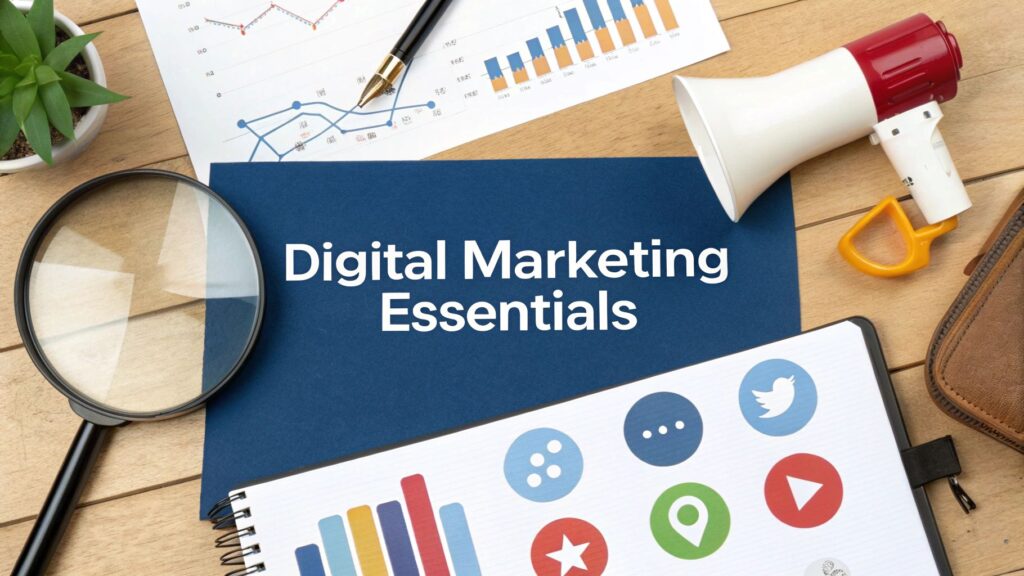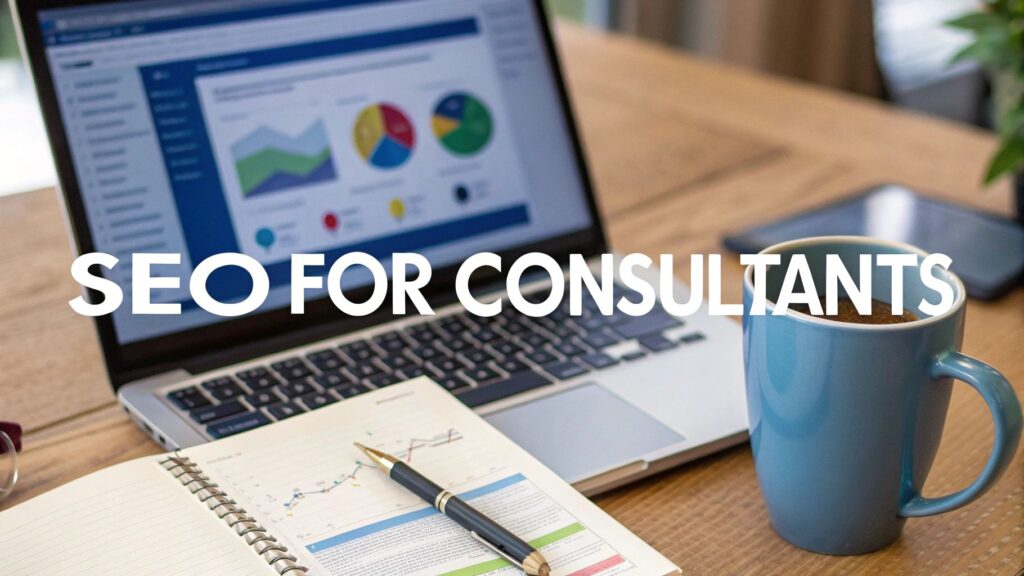Digital marketing services are really just the specific, specialized actions you take to find and connect with your customers online. Think of things like search engine optimization (SEO), managing your social media, or running paid advertising campaigns. They aren’t isolated tasks; they’re all part of a larger system designed to bring people to your brand, turn them into leads, and ultimately, drive sales.
Understanding Your Digital Marketing Toolkit
Before you start pouring money into different tactics, it’s crucial to step back and look at the big picture. I like to think of a business’s online presence like a physical storefront. Your website is the shop itself. All the different digital marketing services are the tools you use to get people in the door, guide them down the aisles, and convince them to buy something.
A great online strategy isn’t built on one-off actions. It’s a connected ecosystem. Search, social media, and content marketing aren’t separate pillars holding up your business; they’re interlocking gears. When one turns, it helps the others move, creating a cycle of growth that’s far more powerful than anything you could achieve with a single activity.
The Core Service Categories
To build a solid marketing foundation, you first need to get a handle on the main types of services. Each one has a very specific job, but they truly shine when you combine them strategically. A holistic approach makes sure all your efforts are in sync, which stops you from wasting money and really cranks up your results.
Let’s break down the main categories to see how they all fit together.
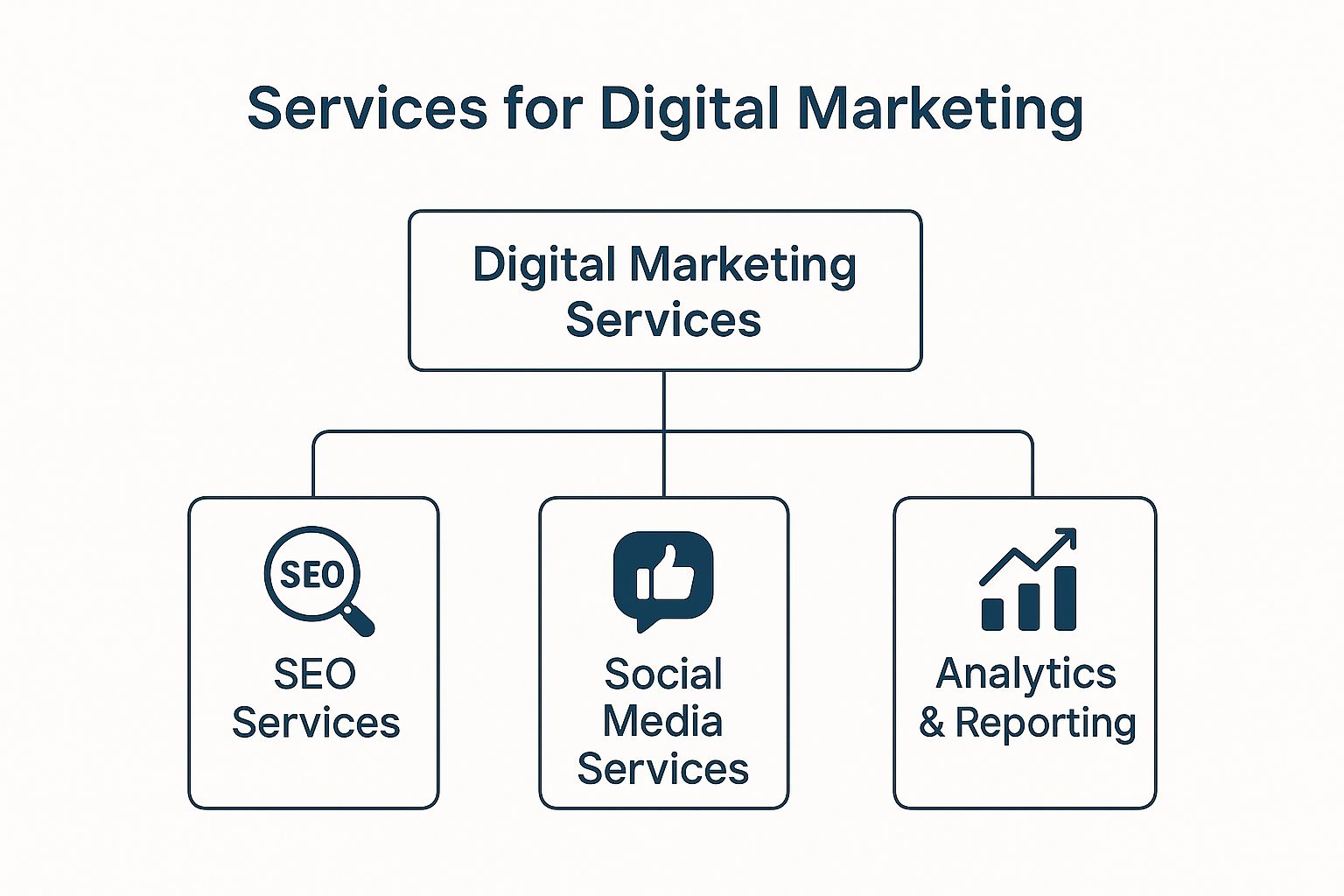
As you can see, foundational activities like SEO and social media are constantly measured and improved through analytics and reporting. This creates a feedback loop that helps you get better over time.
To give you a quick reference, this table summarizes the main service categories and what they’re designed to achieve.
Core Digital Marketing Service Categories at a Glance
| Service Category | Primary Goal | Key Channels |
|---|---|---|
| Search Engine Optimization (SEO) | Increase organic visibility and drive traffic from search engines. | Google, Bing |
| Social Media Marketing (SMM) | Build a community, engage with an audience, and drive brand awareness. | Facebook, Instagram, LinkedIn, X |
| Content Marketing | Attract, educate, and retain an audience by creating valuable content. | Blogs, Videos, eBooks, Whitepapers |
| Paid Advertising (PPC) | Generate immediate traffic and leads by paying for ad placements. | Google Ads, Social Media Ads |
| Email Marketing | Nurture leads, retain customers, and drive direct sales. | Newsletters, Automated Campaigns |
| Analytics & Reporting | Measure performance, track ROI, and inform strategic decisions. | Google Analytics, SEMrush |
Understanding these distinct roles is the first step. The next is seeing how they work together to create something bigger than the sum of their parts.
How These Services Collaborate
Let’s walk through a real-world example. Imagine you publish an amazing blog post (Content Marketing). Just hitting ‘publish’ isn’t enough.
To make sure people actually find it, you optimize it for search engines (SEO Services). This helps it show up when potential customers are searching for that exact topic. Then, you share that same article across your social media channels (Social Media Services) to get it in front of your followers and hopefully, reach new people who might be interested.
The real magic happens when these services create a seamless customer journey. A person might discover your brand through a Google search, follow you on Instagram, and eventually become a loyal customer after receiving a valuable email newsletter.
This interconnected system just works. It meets customers wherever they happen to be, using different touchpoints to build trust and gently guide them toward making a purchase.
Here’s how these partnerships play out:
- SEO + Content: This is your long-term powerhouse. You create genuinely helpful resources that attract organic traffic for months, or even years, to come.
- Social Media + Content: This combo gets your valuable content out to a much wider audience, helping you build a community and show off your brand’s personality.
- Analytics + Everything: This is the brain of the operation. Analytics gives you the hard data to see what’s working and what’s not. Without it, you’re just guessing and have no real way to measure your return on investment.
Once you grasp this collaborative nature, you can start picking the right mix of services that actually line up with your business goals. That way, every dollar and every hour you spend is pushing you in the right direction.
Driving Organic Growth with SEO Services
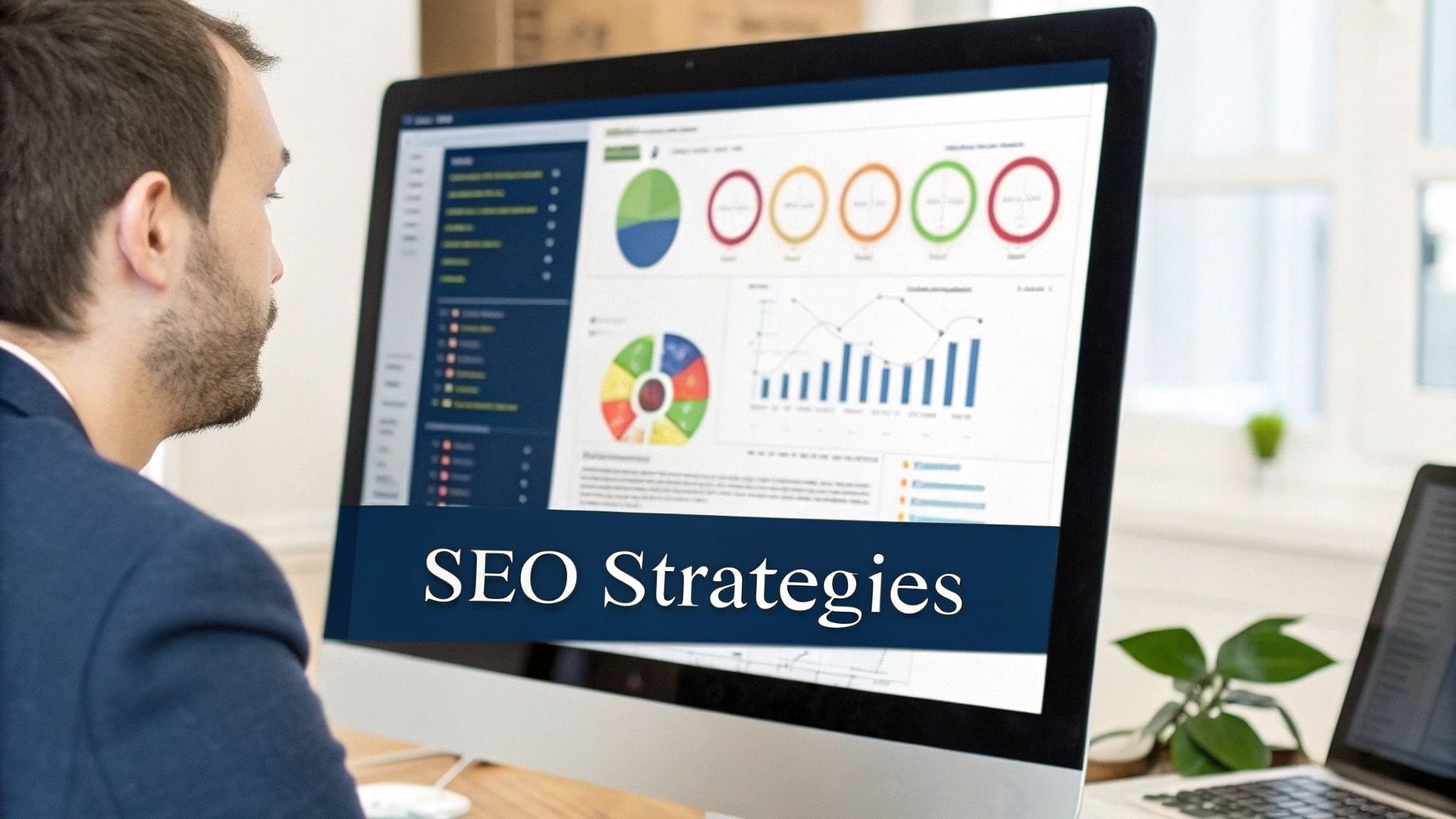
At its heart, Search Engine Optimization (SEO) is the craft of making your website impossible for search engines—and your customers—to ignore. Think of it this way: you could have the best shop in town, but if it’s tucked away in a back alley, no one will ever find it. SEO is how you secure a prime spot on the digital main street.
It’s easily one of the most powerful services for digital marketing because it’s about earning attention, not just paying for it. The goal is to send clear signals to search engines like Google that your website is a credible, valuable answer to what people are looking for. Get this right, and you’ll build digital authority that pays you back with a steady stream of organic traffic for years.
The Three Pillars of SEO
Great SEO isn’t about one magic trick; it’s a strategic blend of three core disciplines working together. You can’t just focus on one and expect results—it’s the combination that creates a strong foundation that search engines reward with higher rankings.
Here are the three pillars you need to know:
- Technical SEO: This is all about the nuts and bolts of your website. It’s the behind-the-scenes work that makes sure search engine crawlers can easily find, understand, and index your site without hitting any roadblocks.
- On-Page SEO: This pillar is focused on the content your visitors actually see. It’s about creating high-quality, relevant pages that solve a user’s problem while also using keywords to clearly signal your topic to search engines.
- Off-Page SEO: This is all about your website’s reputation across the internet. It mostly comes down to earning high-quality backlinks from other reputable sites, which act like votes of confidence for your brand.
I like to compare it to building a house. Technical SEO is the solid foundation. On-page SEO is the interior design and clear signage that makes the house welcoming and easy to navigate. And off-page SEO? That’s the word-of-mouth buzz from respected neighbors that gets people to come knock on your door.
How SEO Components Work Together
To really see the magic happen, these three pillars have to be in sync. A technically flawless website is useless without great content, and incredible content will never be found if it’s on a slow, broken site. It’s the synergy that drives real results.
Let’s imagine a local cafe wants to bring in more foot traffic. They’d start with local SEO, a specific type of optimization. First, they make sure their website loads fast on mobile phones (technical SEO). Then, they create a dedicated page with their menu, hours, and what makes their coffee special (on-page SEO).
A successful SEO strategy ensures that every digital touchpoint is optimized to meet both user needs and search engine requirements. This alignment is what ultimately drives visibility and organic growth.
To build their reputation, they get listed in local directories and encourage happy customers to leave reviews online. This builds their off-page SEO authority. Now, when someone nearby searches “best coffee near me,” the search engine sees the cafe’s strong technical base, relevant content, and positive local buzz. The result? They land at the top of the search results, turning a search into a sale.
Mastering the SEO Process
Getting these results isn’t about guesswork; it requires a disciplined approach. Any good SEO campaign moves through a few key phases, with each one building on the last to create lasting momentum.
- Technical Audit: The first step is always a check-up. We need to diagnose the website’s technical health, looking for things like slow page speeds, broken links, or anything else that might confuse search engine crawlers.
- Keyword Research: This is about getting inside your customers’ heads and understanding the exact words and phrases they use. Identifying these high-value keywords helps you create content that speaks their language.
- Content Optimization: With your keywords in hand, you can start creating new content or improving what you already have to make it the absolute best resource for those search queries.
- Link Building: This is an ongoing effort to earn backlinks from other authoritative websites, which proves to search engines that your site is a credible source of information.
This is a continuous cycle of analysis, action, and adjustment. If you’d like to dive deeper, our guide on search engine optimisation consulting breaks down exactly how to build a winning strategy. SEO is a marathon, not a sprint, but it’s a race that rewards those who stick with it.
Accelerating Results with Paid Advertising
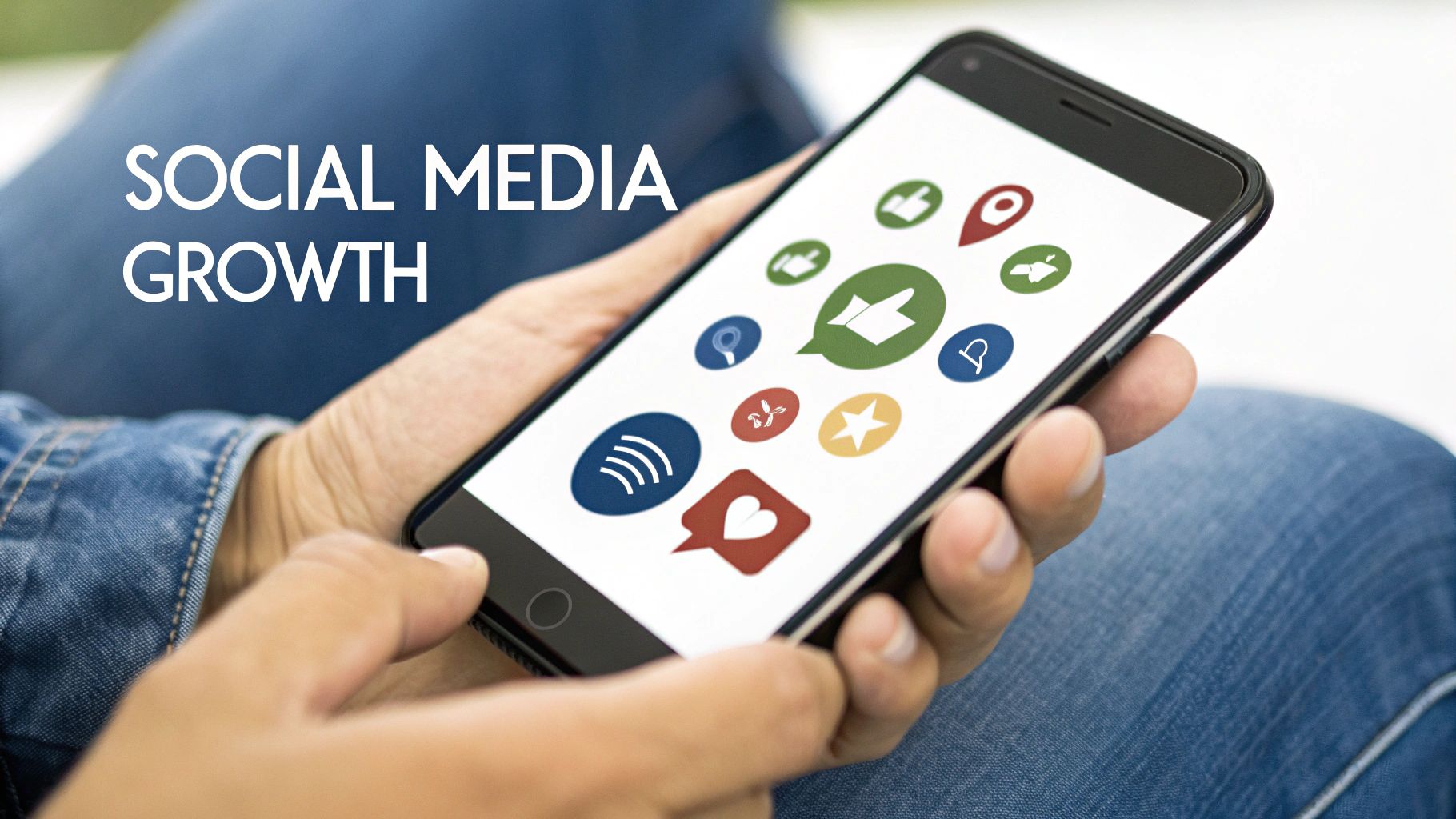
While SEO is the long game—a marathon for building lasting digital authority—sometimes you just need a sprint. You need to get in front of customers right now. That’s where paid advertising, often called Pay-Per-Click (PPC), comes in. It’s your express lane to the top of the search results.
Think of it like this: SEO is like carefully planting, cultivating, and growing an orchard. It takes time, but eventually, you have a valuable asset that produces fruit season after season. PPC, on the other hand, is like setting up a stall at the busiest farmers’ market in town. You pay for the prime spot, and instantly, you have a stream of people ready to buy.
This immediacy is what makes paid ads so powerful. It allows you to test offers, target incredibly specific groups of people, and start generating traffic and leads from day one. It’s one of the most direct and measurable services for digital marketing you can invest in.
Navigating the World of PPC
Paid advertising isn’t a one-size-fits-all tool. It’s a whole toolbox, with different channels designed to reach people in different moments.
You have a few major players to choose from:
- Search Ads: These are the ads you see at the very top of Google or Bing. They’re incredibly effective because they catch people who have “high intent”—meaning they are actively typing in a problem or a product they need, right at that moment.
- Social Media Ads: Ads on platforms like Instagram, Facebook, and LinkedIn let you slide right into your audience’s daily scroll. Their real magic lies in hyper-specific targeting, allowing you to reach people based on their hobbies, job titles, recent life events, and more.
- Display Ads: Ever see those visual banner ads on news sites or blogs? Those are display ads. They are fantastic for building brand awareness and reminding people who have already visited your site that you’re still around (a tactic known as retargeting).
Each format demands its own creative touch, but they all run on a bidding system where you pay for a user’s attention, usually in the form of a click or an impression.
Introducing Retail Media: The New Digital Shelf Space
A corner of the paid ad world that’s exploding right now is retail media. Imagine placing an ad for your product directly on the digital shelf of Amazon or Carrefour, just as a customer is about to make a purchase. That’s the power of retail media.
These giant e-commerce sites have become search engines in their own right, and shoppers go there with their wallets already out. Advertising on these platforms lets you influence the final, critical decision in the buying journey.
Retail media is a game-changer because it closes the gap between seeing an ad and clicking “buy.” It gives you access to a goldmine of first-party shopper data, leading to highly effective campaigns with a crystal-clear ROI.
For any brand selling physical products online, getting a handle on retail media isn’t just a good idea—it’s becoming essential.
The global shift to digital is undeniable, and it’s picking up serious speed in certain regions. For example, the MENA advertising market is on track to grow by 8% in 2025, hitting a total revenue of $6.3 billion. What’s driving this? Digital. Pure-play digital advertising is expected to account for a massive 65.9% of all ad revenue by then. This trend shows why a nimble marketing strategy that includes retail media is no longer optional.
Finding Your Ideal Advertising Mix
The best part about paid advertising is its flexibility. You don’t have to bet everything on one channel. In fact, the most successful strategies blend different ad types to guide customers smoothly. A search ad might capture their initial curiosity, and a social media retargeting ad can pop up later to seal the deal.
This integrated approach is a key component of what we call Search Engine Marketing (SEM). To get a better sense of how it all fits together, check out our guide that breaks down what is search engine marketing. Ultimately, the right combination of paid services for digital marketing always comes down to your unique goals, budget, and who you’re trying to reach.
Building Your Brand with Content and Social Media

If SEO and PPC are the magnets that pull people to your digital doorstep, think of content and social media as the warm welcome that convinces them to come inside. These services for digital marketing are where your brand stops being just a logo and starts having a personality. This is how you give your business a voice and give customers a real reason to stick around.
This powerful duo isn’t about the hard sell. Instead of just shouting “buy from us,” you’re creating and sharing things your audience actually finds useful, entertaining, or interesting. This builds incredible trust and positions you as an expert in your field, not just another vendor.
The Power of Value-Driven Content Marketing
Content marketing is all about creating and sharing valuable stuff to attract the right kind of audience. Picture yourself as the go-to expert your customers wish they could call for advice. You’re not interrupting their day with an ad; you’re earning their attention by helping them solve a problem.
When you consistently offer this kind of value, something amazing happens. People start to see you as a reliable resource, which makes them far more likely to turn to you when they’re finally ready to buy.
Content marketing is a long-term relationship, not a one-time transaction. By educating and empowering your audience, you cultivate loyalty that outlasts any single advertising campaign.
This long-game approach is what creates a sustainable engine for growth. A single great blog post or video can keep pulling in organic traffic and generating leads for months—or even years—delivering a fantastic return on your initial effort.
Unlocking Community with a Smart Social Media Strategy
Once you have this great content, social media is the perfect stage to share it. These platforms aren’t just digital billboards; they’re more like buzzing town squares where conversations about your industry are already taking place. A smart social media strategy lets you join those conversations and, eventually, lead them.
But remember, each platform has its own vibe and set of rules.
- LinkedIn: The place to be for B2B. Share in-depth articles, professional insights, and establish yourself as an authority in your space.
- Instagram & TikTok: Perfect for visual brands. It’s all about telling stories with compelling images and videos, showing behind-the-scenes content, and connecting with younger audiences.
- Facebook: A true all-rounder. You can build tight-knit community groups, share all kinds of content, and run incredibly specific ad campaigns.
The goal isn’t to be everywhere. It’s to be where your ideal customers actually spend their time. By sharing your helpful content and engaging in real conversations, you can turn passive followers into a loyal community of advocates who will champion your brand for you.
This direct line to your audience is incredibly powerful, especially in fast-growing markets. Take the Middle East & Africa (MEA) region, which is seeing a massive boom in e-commerce and social media usage. In 2024, the digital advertising market there hit USD 31,987.6 million in revenue, and a whopping 55.36% of that came from smartphones. That kind of growth highlights just how essential a mobile-focused social and content strategy is today.
When you weave content creation and social media together, you create a powerful feedback loop. The chats on social media spark ideas for new content, and that new content drives even more engagement. It’s a self-sustaining cycle of brand growth and customer loyalty.
Making Smarter Decisions with Analytics and Automation
Let’s be honest, effective digital marketing isn’t about throwing things at the wall and seeing what sticks. It’s about data-driven precision. While things like SEO, paid ads, and social media create the buzz, analytics and automation are the strategic brains behind the entire operation. These are the crucial services for digital marketing that let you measure what’s actually working and then scale that success without burning out your team.
Think of analytics as the dashboard in your car. It doesn’t physically move the car, but you wouldn’t get very far without knowing your speed, how much gas you have left, or if the engine’s about to overheat. Marketing analytics does the same thing for your campaigns, showing you exactly how they’re performing so you can make smart adjustments instead of just driving blind.
Turning Data into Actionable Insights
Tools like the ever-present Google Analytics give you a direct window into how people behave on your site. They do a lot more than just count visitors; they tell you the story behind the numbers.
You can dig into critical details like:
- User Behaviour: Which pages are people lingering on? At what point do they get bored and click away?
- Conversion Tracking: How many visitors actually took the plunge and filled out your form or bought your product?
- Audience Demographics: Where are your best customers coming from? What are their general interests?
This kind of data is pure gold. It helps you calculate a real return on investment (ROI) and shows you exactly where to put more fuel on the fire and where to ease off the gas, making every dollar in your budget work harder.
By consistently keeping an eye on your performance metrics, you stop making guesses and start making genuinely informed decisions. It’s this feedback loop that allows you to constantly refine your strategy and build real, sustainable growth.
The need to get a handle on this data isn’t just a trend; it’s a massive market shift. In the Middle East alone, spending on digital marketing software hit USD 3,893 million in 2024. That number is expected to explode to USD 12,391 million by 2033. This massive investment highlights just how essential data-focused tools have become for managing campaigns and understanding results.
Scaling Your Success with Marketing Automation
Once analytics tells you what’s working, marketing automation is how you do more of it, but with way less manual effort. It’s like hiring a super-efficient assistant who works 24/7 to nurture leads and engage your customers. It takes all those repetitive tasks off your plate, freeing up your team to focus on the big-picture strategy and creative work.
A classic example is an automated email sequence. A visitor downloads an e-book, and your automation software kicks in, sending a pre-planned series of helpful follow-up emails over the next few weeks. These emails can share related blog posts, answer common questions, and gently nudge that person toward becoming a paying customer—all without you lifting a finger.
But this technology isn’t just for email anymore. Marketing automation can also:
- Personalize Content: Show different pop-ups or headlines to website visitors based on their previous actions.
- Streamline Lead Nurturing: Automatically score leads based on how engaged they are, helping your sales team focus on the hottest prospects first.
- Integrate Systems: Connect your CRM with your other marketing tools to build a single, unified profile for every customer.
By automating these crucial (but tedious) tasks, you can deliver a much more consistent and personal experience to a much larger audience. If you want a closer look at how this can transform your operations, see our guide on how to automate business processes for a huge efficiency boost.
Ultimately, analytics tells you what to do, and automation gives you the power to do it at scale. Together, they create a smarter, more effective marketing machine.
Choosing the Right Digital Marketing Services for Your Goals
There’s no magic formula for digital marketing. The strategy that works wonders for a global software giant would be a complete waste of money for a local bakery. The real key is to figure out your end goal first and then work backward from there, making sure every tactic and every dirham of your budget is tied to a specific, measurable objective.
Think of it like packing for a vacation. You wouldn’t throw the same clothes in your suitcase for a ski trip to the Alps as you would for a beach holiday in the Maldives. Your destination—your business goal—tells you exactly what you need to bring. It’s the same with marketing; your unique goals determine which services you need in your toolkit.
Matching Services to Real-World Business Scenarios
Let’s get practical and see how this plays out. Different types of businesses need completely different combinations of services to get the results they’re after.
Here are a few common scenarios:
- The Brand-New Local Restaurant: What do they need? People in seats, right now. Their strategy should be laser-focused on Local SEO, making sure they pop up in “near me” searches and on Google Maps. They’d also want to go all-in on a visual platform like Instagram, posting mouth-watering food photos to connect with the local community.
- The B2B Tech Company: This business isn’t looking for foot traffic; it needs qualified leads for its sales team. The playbook here is totally different. The focus shifts to professional networks like LinkedIn, using highly targeted ads and creating in-depth content (think whitepapers and case studies) to build credibility and get contact info from key decision-makers.
- The Online Fashion Brand: For an e-commerce store, it’s all about driving online sales. This means a serious investment in Pay-Per-Click (PPC) advertising through Google Shopping and social media ads to catch people who are ready to buy. They’d also pair that with influencer marketing to create buzz and build social proof.
Each of these businesses uses a wildly different mix of services, all because their definition of success is fundamentally different.
Choosing the right services isn’t about doing a little bit of everything. It’s about making smart, strategic bets on the channels that will have the biggest and most direct impact on your specific business goals.
A Checklist for Getting Your Strategy Right
Before you commit a single dirham to any digital marketing service, you need to get crystal clear on your direction. Ask yourself—or any agency you’re considering—these critical questions. The answers will form the foundation of a strategy that actually works.
- What’s our number one business goal? Be specific. Is it to increase online sales by 20%? Generate 50 qualified leads per month? Boost local foot traffic?
- Who are we really trying to reach? Where does your ideal customer hang out online? What kind of content do they actually care about?
- What’s our realistic budget? This is a huge factor. It determines whether you can go for quick wins with paid ads or if you need to play the long game with SEO.
- How fast do we need to see results? Are you looking for an immediate traffic spike from PPC, or can you invest in the slower, more sustainable growth that comes from content and SEO?
- How will we know if it’s working? You have to define what success looks like from day one. Nail down your Key Performance Indicators (KPIs) before you start.
Frequently Asked Questions
Diving into digital marketing often brings up a lot of questions. Let’s tackle some of the most common ones that business owners ask so you can move forward with more confidence.
How Much Should a Small Business Really Spend on Digital Marketing?
There’s no one-size-fits-all answer, but a good rule of thumb is to set aside 7-10% of your total revenue for your marketing budget. If you’re just getting started, though, it’s smarter to pick a number you’re comfortable with for a “test and learn” phase.
Don’t try to be everywhere at once. Funnel that initial budget into one or two channels that make the most sense for your business right now. A local coffee shop, for instance, would get more mileage from local SEO and a strong Instagram presence, whereas a B2B tech company should probably be living on LinkedIn. Once you see what’s bringing in results, you can scale up your investment.
What’s the Difference Between Hiring an Agency and Building My Own Team?
This really comes down to a classic trade-off: specialized expertise versus deep-seated brand knowledge. The main differences boil down to cost, available skills, and how much control you want.
- Hiring an Agency: You instantly get a full team of specialists—an SEO pro, a PPC wizard, a content creator—and access to all the expensive tools they use. This is almost always more cost-effective than hiring individual experts for each role.
- Building an In-House Team: Having your own team means they live and breathe your brand every single day. You get total control over strategy and can pivot on a dime. The downside? It’s a major investment in salaries, benefits, training, and software.
Your best bet depends on your budget, how fast you’re growing, and the specific skills you need. Many businesses actually land on a hybrid approach, using an agency to handle the heavy lifting while their in-house person focuses on brand strategy. It’s a great way to get the best of both worlds.
How Long Until I See Results from SEO?
Let’s be honest: SEO is a marathon, not a sprint. It’s about building a solid foundation and earning trust with search engines, which simply takes time.
You’ll likely start to see some early positive signs—like climbing a few spots in the rankings—within 3-6 months. But for the really meaningful results, like holding a top spot on the first page for keywords that matter, you’re typically looking at 6-12 months of consistent, quality work.
Think of it this way: paid ads are like renting an apartment. The moment you stop paying rent, you’re out. SEO is like buying a house; the equity you build over time becomes a valuable, long-term asset for your business.
Ready to build a marketing plan that actually moves the needle? The team at Invocom specializes in combining powerful digital marketing services—from SEO and Google Ads to full system automation—to help you grow faster. Find out how we can help by visiting us at https://invocom.me.

